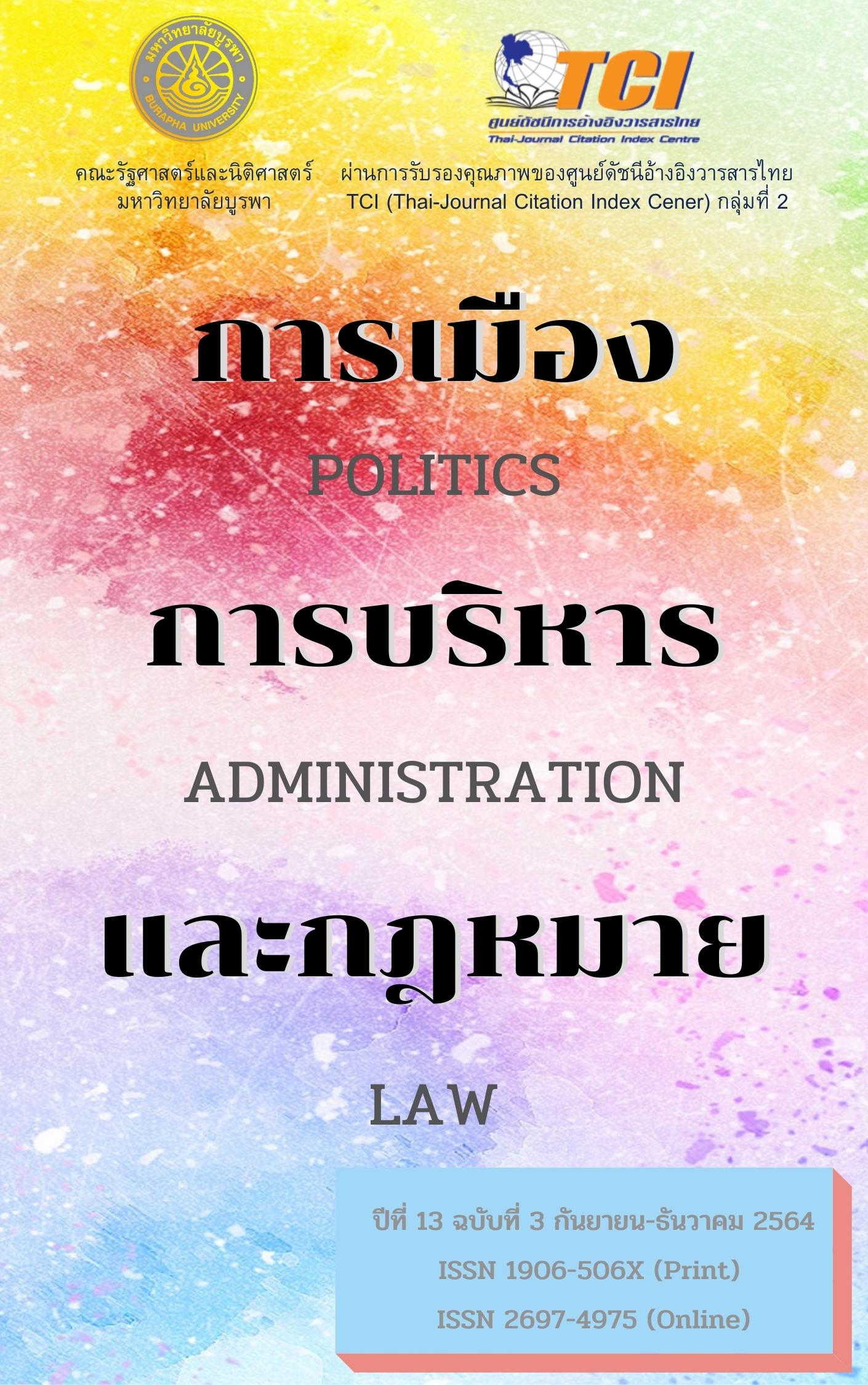A Model of Organizational Leadership to Develop Highly Effective Followers
Keywords:
Development, Leadership, Follower, EffectiveAbstract
Building good managerial relationships and developing subordinates can increase productivity and keep good employees in the organization over the long term. By learning to be transformational leaders, you can learn the following: 1) Idealized Influence or Charisma with ideology, vision, managerial abilities, Emotional and ethical. 2) Inspirational motivation is a motivation within, such as creating positive attitudes and encouraging team spirit to come alive. 3) Intellectual stimulation is the leader encourage followers to be mindful of problems that arise in the organization and department. Causing followers to find new solutions to solve problems by finding a better conclusion to bring about something new and creative. 4) Individualized consideration, The leader relates to the individual as a leader in caring for individual followers and make followers feel valued and important. Leader will act as coach and advisor for follower development. In conclusion, it can be said that being a good leader sacrifice must be known, listen to the opinions of the followers as well as to set a good example for the followers to obey and perform the work as the leader commands. These behaviors will enable employees to produce quality, low-cost products, services deliver on time and satisfying the customer (Bass, 1985 cited by Sophon Phukao). A follower can develop to become a leader. The highly effective follower will be able to accomplish the task of accomplishing the organization's goals. It should have the following characteristics: 1) Able to think and make self-management planning, seeing that they have the ability to manage as leaders as well; 2) Work with determination and adhere to the ultimate goals of the organization. If encountering problems and obstacles in the operation, it will consider modifying the working direction or requesting changes in the leadership. 3) Strengthening and continually developing oneself by striving to learn and practice skills and expertise. To looking for additional special responsibility jobs with pleasure and responsible for the work. 4) Have courage by take risks to think, say and do, even if you make a mistake. To giving leaders and people in the organization confidence and Trust (Wachakana Kanjanaphat, 2013, p. 46). As for the relationship between leaders and followers, it is important to retain employees. Quality to be with the organization for a long time is a policy factor that can drive and create an organizational culture for all employees as a guideline for action such as management of quality systems throughout the organization. Establishing an organization's strategy Human Resource Management Developing organizations in various fields as well as being a learning organization. The researcher used a combination of research. Using Qualitative Research Methodology and Quantitative Research study the relationship to the development of leaders and followers from organizations that received the TQA (Thailand Quality Award) and well-managed organizations. In-depth interviews were used to collect data from senior executives who were Thai nationals and using Quantitative research methodology by using important variables of each organization to synthesize information through content analysis to do questionnaires and using descriptive statistics in interpreting various meanings by confirm the research results with a focus group.
References
แก้วตา ผู้พัฒนพงศ์. (2550). คุณภาพชีวิตการทำงานของอาจารย์ในมหาวิทยาลัยไทย. ดุษฎีนิพนธ์ปรัชญาดุษฎีบัณฑิต, สาขาวิชารัฐประศาสนศาสตร์, คณะรัฐศาสตร์, มหาวิทยาลัยรามคำแหง.
จันทนา แสนสุข. (2557). ปัจจัยที่เป็นเหตุและผลของความสามารถภาวะผู้นำ. กรุงเทพฯ: วารสารสมาคมนักวิจัย.
จิราพร หมวดเพชร.(2558). ศึกษาเรื่องความสัมพันธ์ระหว่างภาวะผู้นำของผู้บริหารโรงเรียนกับประสิทธิผลของโรงเรียนเอกชน จังหวัดสงขลา. ชลบุรี: มหาวิทยาลัยบูรพา.
นิสดารก์ เวชยานนท์. (2548). การบริหารทรัพยากรมนุษย์: เอกสารประกอบการสอน วิชา รศ. 620 = Human resource management. กรุงเทพฯ: คณะรัฐประศาสนศาสตร์ สถาบันบัณฑิตพัฒนบริหาร ศาสตร์.
โสภณ ภูเก้าล้วน. (2555). ภาวะผู้นำการเปลี่ยนแปลง. วันที่ค้นข้อมูล 23 พฤศจิกายน 2563, เข้าถึงได้จาก https://www.gotoknow.org/posts/108887
ชุลีพร เพ็ชรศรี. (2557). คุณลักษณะของผู้ตามและบรรยากาศองค์กรที่มีอิทธิพลต่อประสิทธิภาพการปฏิบัติงานของพนักงาน กรณีศึกษา กลุ่มธุรกิจเทคโนโลยีสารสนเทศและการสื่อสาร. สุทธิปริทัศน์, 28(85),145-160.
ภัทรีย์ จันทรกองกุล. (2550). ปัจจัยที่มีผลต่อการรักษาและประสิทธภาพในการทำงานของบุคลากรด้านเทคโนโลยีสารสนเทศ: กรณีศึกษา บริษัท ตลาด ดอท คอม จํากัด. วันที่ค้นข้อมูล 23 พฤศจิกายน 2563, เข้าถึงได้จาก http://library1.nida.ac.th/termpaper5/hrd/2550/19242.pdf
ภาคภูมิ ฤกขะเมธ. (2553). องค์การที่มีสมรรถนะสูงในองค์การภาครัฐ: ตามมุมมองของทฤษฎีโครงสร้างตามสถานการณ์และ แนวคิดด้านวัฒนธรรม. Journal of Management Sciences, 27(1-2), 33-46.
วรเดช จันทรศร. (2551). การนำนโยบายไปสู่การปฏิบัติ. กรุงเทพฯ: โรงพิมพ์แห่งจุฬาลงกรณ์.
วรางคณา กาญจนพาที. (2556). ภาวะผู้นำและภาวะผู้ตามที่มีอิทธิพลต่อประสิทธิผลองค์กร: กรณีศึกษาธนาคารเพื่อการส่งออกและนำเข้าแห่งประเทศไทย. ปทุมธานี: มหาวิทยาลัยเทคโนโลยีราชมงคลธัญบุรี.
สามารถ อัยกร, ประภัสสร ดาวะเศรษฐ, สายป่าน จักษุจินดา และชาญชัย ศุภวิจิตรพันธ. (2560). บทบาทของผู้ตามในคุณลักษณะภาวะผู้ตามแบบมีประสิทธิผล. วันที่ค้นข้อมูล 23 พฤศจิกายน 2563, เข้าถึงได้จาก http://mis.ptu.ac.th/journal/data/9-1/9-1-23.pdf
สุเทพ พงศ์ศรีวัฒน์. (2545). บริบทกับการเลือกใช้ภาวะผู้นำแบบเปลี่ยนสภาพและแบบแลกเปลี่ยน. กรุงเทพฯ: บุ๊คลิ้งค์.
สุจิตรา ธนานันท์. (2551). การพัฒนาทรัพยากรมนุษย์ (พิมพ์ครั้งที่ 3). กรุงเทพฯ: หจก. ทีพีเอ็น เพรส.
สุรินทร์ ชุมแก้ว. (2556). วัฒนธรรมองค์การ ภาวะผู้นําแบบสร้างความเปลี่ยนแปลง และพฤติกรรมการทํางานตามหลักปรัชญาของเศรษฐกิจพอเพียงของผู้บริหารในองค์การเอกชน. กรุงเทพฯ: สถาบัน บัณฑิตพัฒนบริหารศาสตร์.
สำนักงานคณะกรรมการพัฒนาการเศรษฐกิจและสังคมแห่งชาติ. (2559). สำนักนายกรัฐมนตรี. วันที่ค้นข้อมูล 23 พฤศจิกายน 2563, เข้าถึงได้จาก https://www.nesdc.go.th/ewt_news. php?nid=7240
Burns, J. M. (1978). Leadership. New York: Harper and Row.
Kelly, R. E. (1992). The Power of Followership. New York: Doubleday.
Kelly, J. (1998). Rethinking Industrial Relations: Mobilization, Collectivism and Long Waves. London: Routledge.
Kossek, E. E., & Block, R. N. (2002). Managing human resources in the 21'st century: From core concepts to strategic choice. South-Western College Publishing.
Mowday, R. T., Porter, L. W., & Steers, R. M. (1982). Employee-Organization Linkages: The Psychology of Commitment, Absenteeism and Turnover. New York: Academic Press.
Downloads
Published
Issue
Section
License

This work is licensed under a Creative Commons Attribution-NonCommercial-NoDerivatives 4.0 International License.






